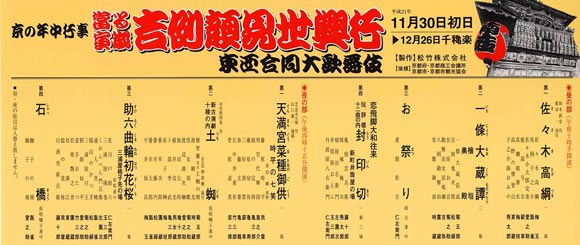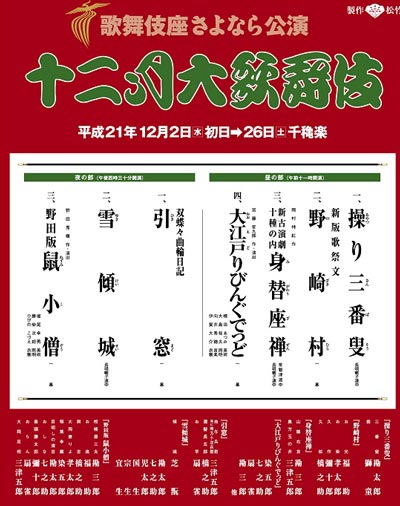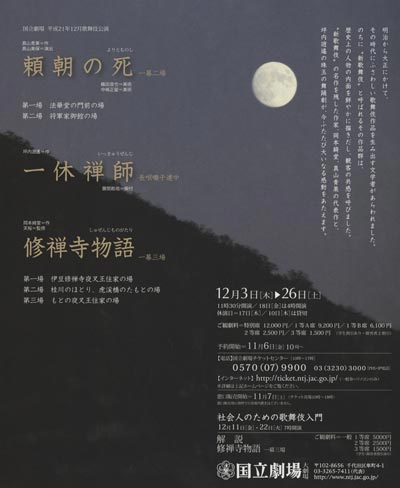| Comments |
Sasaki Takatsuna: This is a modern play by Okamoto Kid˘ (1872 - 1939) who is
famous for inventing the Edo Period style detective story. Sasaki Takatsuna
shows one of the top warriors in the battles that established the Kamakura
shogunate and how he gradually becomes disillusioned with the world of lies
and political intrigue. Starring Nakamura Baigyoku in the role of Takatsuna.
Ichij˘ ďkura Monogatari: the world is ruled by Taira no Kiyomori, the leader of the Heike clan.
Tokiwa Gozen, the widow of the head of the defeated Genji clan and mother of Yoritomo and Yoshitsune,
the future leaders of the clan, has become the mistress of the dictator Kiyomori, then the wife of
Lord ďkura, a seemingly simple-minded fool who spends all his time watching pretty women dance.
Outraged members of the Genji clan sneak into Lord ďkura's mansion only to discover that
Tokiwa Gozen's immorality and Lord ďkura's idiocy are a guise, the only way to survive in a world ruled by the enemy.
This performance stars Onoe Kikugor˘ as Lord ďkura, Nakamura Tokiz˘ as Tokiwa Gozen,
Onoe Sh˘roku as Yoshioka Kijir˘, Onoe Kikunosuke as Yoshioka's wife Oky˘ and Ichikawa Danz˘ as Yatsurugi Kageyu.
Omatsuri: Kataoka Nizaemon as a gallant fireman boss at a festival telling a rueful
tale of failure in love and showing the vigorous work songs of firefighters.
Fűin Giri:
(Breaking the Seals)
In the pleasure quarters, the most important possessions
were money and reputation. In danger of losing his lover, the courtesan Umegawa,
the money courier Kameya Chűbŕ breaks the seals on a package of money entrusted to him
after being taunted by a rival, even though the use of such money is punishable
by death. Featuring the top stars in Kabuki, Sakata T˘jűr˘ as Kameya Chűbŕ, Kataoka Hidetar˘ as Umegawa, Kataoka Nizaemon as Chűbŕ's treacherous friend
Tanbaya Hachiemon, Band˘ Tamasabur˘ (!) as Oen, the proprietress of the teahouse,
and Ichikawa Sadanji as Tsuchiya Jiemon.
Shihei no Nana Warai:
(Shihei's Seven Laughs)
The Heian period court minister Sugawara no
Michizane is famous for being exiled to Kyushu by a political rival.
He died angry and vengeful and was said to be transformed into a thunder god.
His angry spirit was placated by making him a god and now Michizane is worshipped
as Tenjin, the god of learning. This is the subject of one of the most famous
plays of Bunraku and Kabuki ("Sugawara Denju Tenarai Kagami")
and Michizane's political rival, Fujiwara no Shihei,
is always depicted as a larger-than-life villain, an evil courtier with magical
powers. This play, a rarely performed classic of the Kansai style of Kabuki,
and reverses the story totally. Michizane (Band˘ Hikosabur˘) is the victim of slander and
Shihei (Kataoka Gat˘) does his best to try to mend the situation, but unfortunately
Michizane is exiled. But after Michizane leaves, Shihei shows his true self
and in a famous scene, laughs triumphantly. Shihei engineered Michizane's exile
himself.
Tsuchi-gumo: a dance play adapted from the classical N˘ theatre.
The samurai Lord Minamoto Raik˘ is famous in legend for ridding Ky˘to of demons.
While Raik˘ is confined to bed with illness, a priest (Onoe Kikugor˘) from a prominent
temple comes to pray for his health. In fact, the priest is actually the spirit
of the earth spider which has caused Raik˘'s illness in the first place
and hopes to destroy him. The spider's plan to kill Raik˘ is defeated
by his retainers (the famous shitenn˘) in an exciting fight.
Featuring Nakamura Tokiz˘ as Raik˘. Featuring also Nakamura Kanjaku, Nakamura Baigyoku, Kataoka Ainosuke, Onoe Kikunosuke, Ichikawa Danz˘ and Onoe Sh˘roku.
Sukeroku: the dandy Sukeroku is the most famous patron of the
Yoshiwara pleasure quarters.
But his reputation as the lover of Agemaki,
the highest ranking courtesan in the quarter is matched by that of his
tendency to pick fights. In fact, Sukeroku is the samurai Soga no Gor˘
in disguise, and he uses the fights to find a lost heirloom sword.
His search takes place in the colorful atmosphere of the Yoshiwara
where processions of beautiful courtesans compete with the splendor of
cherry blossoms in full bloom. All the top stars in Kabuki appear in
a procession of beautiful, exciting and amusing roles.
Starring Kataoka Nizaemon and Band˘ Tamasabur˘ as Hanakawado Sukeroku and Miuraya Agemaki.
Featuring also Sakata T˘jűr˘, Kataoka Gat˘, Nakamura Kanjaku, Ichikawa Sadanji,
Kataoka Ainosuke, Onoe Kikunosuke and Onoe Sh˘roku.
Shakky˘:
(The Stone Bridge)
There are many plays about shishi or lion
spirits in the Asian tradition, but the shishi is not
actually a lion, it is a mythical animal that guards the stone bridge (Shakky˘)
leading to the Buddhist paradise of Monju, the god of wisdom.
Featuring Nakamura Kanjaku and Kataoka Ainosuke in the roles of the shishi.
Source: Earphone Guide website
|



